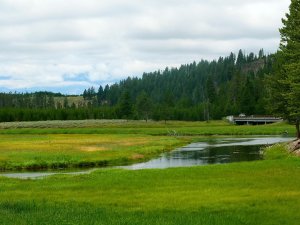by Huston Heatherly
The Madison River might be the most iconic and well-known trout fishery in the United States.
Location
The Madison river begins in Yellowstone National Park and flows through south central Montana for nearly 140 miles with much of this stretch being accessible for fly fishing.
The nearest airport is the Gallatin Field Airport (BZN) in Bozeman, MT. Smaller airports for personal planes are at West Yellowstone and Ennis, MT.
About the Madison River
The Madison river, as it flows through Montana, is generally divided into several different sections, each providing unique fly fishing opportunities.
From it’s origins in Yellowstone to Hebgen Lake, the Madison offers excellent fishing with nearly unlimited access to wading. Special permits will be required to fish this section, and you should also be aware of closings that sometimes occur during this stretch of the river.
Between the Hegben Lake Dam and Quake Lake several miles of river is available for fishing. In this section floating is off limits as this stretch of the river contains a lot of rapids. There are some wading opportunities, but you should be very cautious around parts of this stretch. The river a few miles below this stretch has the same type of water until it reaches Lyons Bridge access point.
The Legendary 50-mile Riffle
The most iconic stretch of the river lies between Quake Lake and Ennis, MT and is coined the 50-mile riffle. This section of the river would not seem to be prime trout habitat with few bolder, pools, or bank undercuts, but it has one of the highest populations of fish and is probably the heaviest fished portion of the river. The gradient and stone bottom of this part of the river results in large stretches of riffles and runs with few deep pools.
Several miles before the Madison river passed the town of Ennis, MT the river slows down and begins to show more structures that look like trout habitat with vegetation along the bank and the characteristic boulders and undercuts that provide respite from the current.
Below Ennis Lake
Below Ennis Lake the river passes through Beartrap Canyon and is mostly extremely fast current with whitewater rapids and little access.
After the river leaves the canyon, it slows down substantially, widens, and contains deeper pools of water. This is a popular float stretch for not only fisherman but recreational boaters.
Types of Fish on the Madison River
In the Yellowstone portion of the river browns, rainbows, and cutts are prominent. During the fall months, there is an influx of browns moving into the area from Hegben Lake.
In the 50-mile riffle section you are looking at fish at the 10+ inch mark at a rate of 1,000 fish per mile with the majority of fish being rainbows, but a fair population of browns in there as well.
Below the Ennis Lake, the trout population falls off, and the main species is the brown trout. While the rate of fish per mile is lower than in other sections trophy browns have been taken from this section of the river.
Best Time to Fish the Madison River
The best time to hit the Yellowstone section is in early spring and fall. During the fall brown trout migrate back upstream from Hegben Lake to spawn.
Post-runoff in the 50-mile riffle section is some of the hottest dry fly fishing that can be had in the US. Late summer to early fall in this section has abundant salmonfly hatches and aggressive top feeding trout.
When fishing the lower sections of the Madison river, especially in the summer, it is important to be on the river early in the morning and to pay attention to water temperature. This section of the river can get warm enough to put trout down metabolically and in some cases lead to a kill of trout.
Madison River Access Points
- Hwy 287
- Raynolds Pass
- 3 dollar bridge
- Valley Garden
- Lyons Bridge
- Varney Bridge
- Ennis Access
- Beartrap Canyon Trailhead
- Hwy 84 Access
- Cobblestone Fishing Access Site
Tactics and Gear
For the majority of fish in the river and the various river sections, the standard 9′ 5 or 6wt fly rod with floating line will take care of your needs. 9-12ft leaders in the 3-6x range will also work well. For specific conditions where other gear is needed, we will highlight in the following tips and tactics.
For those looking to float the Madison river, there are several sections that are closed to floating. These sections include from Hegben Dam to Lyon Bridge and Ennis Bridge to Ennis Lake.
Seasonal Strategies
Fall fishing in the Yellowstone section of the river can lead to huge browns as they migrate upriver to spawn from Hegben Lake. Equipment to handle larger and heavier streamers and potentially large browns should be used such as a 9’ 6wt rod.
During the winter season nymphing with double rigs techniques are very effective when drifted through deeper pools and weed beds. Streamers used in the same pools can also lead to large trout. This technique is extremely popular in the Hegben Dam to Lyons Bridge stretch of the river that features long, deep, and swift pools. A sinking tip line can help get your flies down deep and quick enough to fish these stretches and can work throughout the year.
50-mile Riffle Strategies
The 50-mile riffle is prime fishing after the runoff in the mid-summer months and sports huge salmonfly hatches. As the salmonfly hatch tapers off this stretch still provides excellent dry fly fishing with consistent Caddis hatches that bring fish to the top water. For Caddis and Mayfly hatches on the riffle section, matching the hatch closely is not as important as the fast current has conditioned these fish to take flies quickly from the surface.
Strategies for the Lower Madison
When fishing the Ennis section of the Madison river and the lower portion of the river it is important to closely match the hatch and approach holes cautiously as these fish are much more finicky. The river in these areas is also wider with multiple currents across its width. Closer casts and working out from there is important to keep a drag free drift on your flies.
The Madison river offers a lot of access to the river and more wading opportunities than other rivers in the area. This also means there is a lot of fishing pressure. Walking a half mile to a mile down or upstream from these access points can lead to water with less fishing pressure and more opportunities to land some fish.
Hatches and Flies of Importance
Before going check with local fly shops for up to date hatch information and recommended imitations to bring in your fly box.
Winter
Midges: Sizes 22-26. Pupa, emerger, and adult imitations are all effective in tan and black variations.
BWO: Sizes 16-24
Scuds/sow bugs: Sizes 16-22 in orange and tan variations.
Streamers: Wooly Buggers and Leech patterns in sizes 2-16.
Spring
Midges: Sizes 22-26. Pupa, emerger, and adult imitations are all effective
March Browns: Sizes 10-14. Hatches are usually smaller but usually draw fish to the surface.
BWO: Sizes 16-24
Summer
Stoneflies: Salmonflies (4-8), Golden Stone (6-10) in both adult and nymphal stages.
Caddis: Sizes 14-20 in various color schemes. Emerger patterns are also keyed in on by trout throughout the hatch.
PMDs: Sizes 14-20. Be sure to have some spinner imitations.
Drakes: Sizes 10,12 in both green and brown patterns. More sparse then other hatches but if you find yourself in the middle of this hatch, it can be fantastic fishing.
Tricos: Sizes 18-22. Great hatches later in the summer in the early morning hours. Especially prolific in the Yellowstone section
BWO: Sizes 16-24
Terrestrials: Larger grasshopper patterns sizes 2-10 and ant patterns sizes 14-20.
Fall
BWO: Sizes 16-24.
Caddis: Sizes 14-20
Terrestrials: Larger grasshopper patterns sizes 2-10 and ant patterns sizes 14-20.
Streamers: Wooly Buggers and Leech patterns in sizes 2-16.
Area Guide Services
In this area you can find a guide service for every budget level.
Montana Fly Fishing Regulations and Property Rights

Find out the necessary Montana Fishing Regulations before you go.
Rights and responsibilities of the landowner and the fisherman in Montana.
